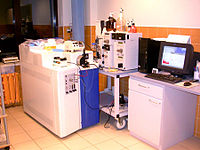Tandem mass spectrometry

Tandem mass spectrometry is a fancy way of measuring and analyzing tiny things that are too small for us to see with our eyes. It works a bit like a magic sorting machine that separates different things based on their weight and shape.
Imagine you have a big jar of different candies with different colors and flavors mixed together. You want to know what kind of candies are in the jar, but you can't just look inside and see each candy one by one.
So, you take the jar and shake it really hard, so that the candies start spreading out and bumping into each other. Then, you pour the candies out onto a flat surface, like a table.
Now, you can start sorting the candies by color and shape. You put all the green gummies in one pile, all the red hard candies in another pile, and so on. This way, you can see exactly how many candies of each type you have in the jar.
Tandem mass spectrometry works a bit like this. Scientists take very tiny samples of things that they want to analyze, like chemicals or proteins. Then, they use a machine that can break apart the sample into smaller pieces, just like shaking the jar of candies.
After the sample is broken apart, the machine measures the weight and shape of each small piece, and sorts them into different piles. This helps scientists identify the different parts of the sample and figure out what they're made of.
It's like taking the green gummies and looking at their shape and taste to figure out what ingredients went into making them. Scientists can use tandem mass spectrometry to identify different chemicals, study how proteins work, and even diagnose diseases.
Imagine you have a big jar of different candies with different colors and flavors mixed together. You want to know what kind of candies are in the jar, but you can't just look inside and see each candy one by one.
So, you take the jar and shake it really hard, so that the candies start spreading out and bumping into each other. Then, you pour the candies out onto a flat surface, like a table.
Now, you can start sorting the candies by color and shape. You put all the green gummies in one pile, all the red hard candies in another pile, and so on. This way, you can see exactly how many candies of each type you have in the jar.
Tandem mass spectrometry works a bit like this. Scientists take very tiny samples of things that they want to analyze, like chemicals or proteins. Then, they use a machine that can break apart the sample into smaller pieces, just like shaking the jar of candies.
After the sample is broken apart, the machine measures the weight and shape of each small piece, and sorts them into different piles. This helps scientists identify the different parts of the sample and figure out what they're made of.
It's like taking the green gummies and looking at their shape and taste to figure out what ingredients went into making them. Scientists can use tandem mass spectrometry to identify different chemicals, study how proteins work, and even diagnose diseases.
Related topics others have asked about:
